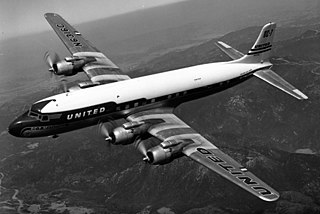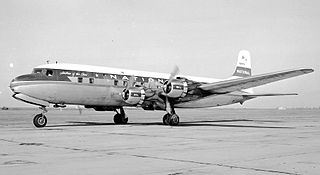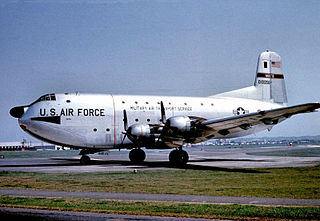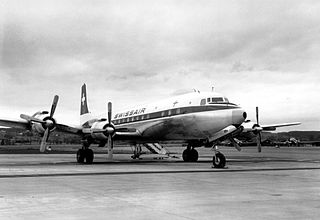
The Douglas DC-7 is an American transport aircraft built by the Douglas Aircraft Company from 1953 to 1958. A derivative of the DC-6, it was the last major piston engine-powered transport made by Douglas, being developed shortly after the earliest jet airliner—the de Havilland Comet—entered service and only a few years before the jet-powered Douglas DC-8 first flew in 1958. Larger numbers of both DC-7B and DC-7C variants were also built.

National Airlines Flight 2511 was a United States domestic passenger flight from New York City to Miami, Florida. On January 6, 1960, the Douglas DC-6 serving the flight exploded in midair. The National Airlines aircraft was carrying 5 crew members and 29 passengers, all of whom perished. The Civil Aeronautics Board investigation concluded that the plane was brought down by a bomb made of dynamite. No criminal charges were ever filed, nor was the blame for the bombing ever determined, though a suicide bombing is suspected. The investigation remains open.

United Air Lines Flight 409 was a scheduled flight which originated in New York City, New York. The final flight destination was San Francisco, California, with stops in Chicago, Denver and Salt Lake City. The aircraft operating the service, a Douglas DC-4 propliner, registration N30062, crashed into Medicine Bow Peak, near Laramie, Wyoming, on October 6, 1955, killing all 66 people on board. The victims included five female members of the Mormon Tabernacle Choir and military personnel. At the time, this was the deadliest airline crash in the history of American commercial aviation. Another 66 lives had been lost earlier that year in the March 22 crash in Hawaii of a United States Navy Douglas R6D-1 Liftmaster military transport aircraft, and 66 had also died in the mid-air collision of two United States Air Force C-119G Flying Boxcars over West Germany on August 11, placing the three crashes in a three-way tie as the deadliest aviation incidents in 1955.

On March 12, 1948, Northwest Airlines Flight 4422 (NC95422) crashed into Mount Sanford, Alaska, with a crew of six and 24 passengers. The flight was a C-54 charter flying back to the United States from Shanghai. The aircraft refueled at Anchorage and took off at 8:12 P.M. to continue on to its destination, New York City. Instead of following the published airway, which detoured around Mount Sanford, the aircraft flew a direct line, crashing into the mountain. After the initial impact the wreckage slid down for about 3000 feet before coming to rest. There were no survivors. The passengers were American merchant mariners, crew members of the tanker SS Sunset, being ferried back home.

On August 31, 1940, Pennsylvania Central Airlines Trip 19, a new Douglas DC-3A, was flying from Washington, D.C. to Detroit with a stopover in Pittsburgh. While the aircraft was flying near Lovettsville, Virginia at 6,000 feet (1,800 m) and approaching the West Virginia border, Trip 19 encountered an intense thunderstorm. Numerous witnesses reported seeing a large flash of lightning shortly before it nosed over and plunged to earth in an alfalfa field. With limited accident investigation tools at the time, it was at first believed that the most likely cause was the plane flying into windshear, but the Civil Aeronautics Board report concluded that the probable cause was a lightning strike. U.S. Senator Ernest Lundeen was among the 21 passengers and 4 crew members killed. Also on board were "a Special Agent of the FBI, a second FBI employee, and a prosecutor from the Criminal Division of the U.S. Department of Justice." At the time of the crash, the FBI was investigating Sen. Lundeen's ties to George Sylvester Viereck, a top Nazi spy working in the US to spread pro-Hitler and anti-Semitic propaganda.

Pan American World Airways Flight 202 was a Boeing 377 Stratocruiser aircraft that crashed in the Amazon Basin about 281 nautical miles southwest of Carolina, Brazil on April 29, 1952. The accident happened en route from Rio de Janeiro, Brazil, to Port of Spain, Trinidad and Tobago, during the third leg of a four-leg journey. All 50 people on board were killed in the deadliest-ever accident involving the Boeing 377.

Northwest Orient Airlines Flight 2 was a Boeing 377 Stratocruiser aircraft that was ditched into Puget Sound, just off Maury Island at the Point Robinson Light, shortly after takeoff from Seattle-Tacoma International Airport (Sea-Tac) on the morning of Monday, April 2, 1956.

West Coast Airlines Flight 956 was a scheduled commercial flight in the western United States which crashed on October 1, 1966, approximately 5.5 miles (9 km) south of Wemme, Oregon, southeast of Portland. Thirteen passengers and five crew members were aboard, but none survived. In its first week of service, the aircraft was destroyed by the impact and subsequent fire.
Transocean Air Lines was an airline based in the United States that operated from 1946, when it was established as ONAT (Orvis Nelson Air Transport Company), until its bankruptcy in 1960. It was based in Oakland, California.
In aeronautics, loss of control (LOC) is the unintended departure of an aircraft from controlled flight and is a significant factor in several aviation accidents worldwide. In 2015 it was the leading cause of general aviation accidents. Loss of control may be the result of mechanical failure, external disturbances, aircraft upset conditions, or inappropriate crew actions or responses.

The 1952 Mount Gannett C-124 crash was an accident in which a Douglas C-124 Globemaster II military transport aircraft of the United States Air Force crashed into Mount Gannett, a peak in the Chugach Mountains in the American state of Alaska, on November 22, 1952. All of the 52 people on board were killed.

Alaska Airlines Flight 779 was a contract cargo flight operated on 21 July 1961 by an Alaska Airlines Douglas DC-6A that crashed short of the runway at Shemya Air Force Base with the loss of all six crew members on board.

Pan Am Flight 799 was an international cargo flight from Los Angeles International Airport to Cam Ranh Airport in South Vietnam that crashed on December 26, 1968, near Anchorage, Alaska. The aircraft involved was a Boeing 707-321C aircraft operated by Pan American World Airways. All three crew members died in the crash.

Capitol International Airways Flight C2C3/26 was a chartered McDonnell Douglas DC-8 Military Airlift Command (MAC) contract flight operated by Capitol Air from McChord Field in Tacoma to Cam Ranh Bay in Southern Vietnam via stopovers at Anchorage and at Yokota Air Base in Japan. The aircraft crashed after a botched take-off attempt from Runway 6R at Ted Stevens Anchorage International Airport on November 27, 1970. Of the 229 people aboard the jet, 47 perished due to the post-crash fire with 49 people injured.

The crash of Northwest Orient Airlines Flight 1–11 was an accident involving a Douglas DC-7C of the American airline Northwest Orient 8 km (5.0 mi) northeast off Polillo Island, Quezon, Philippines, on July 14, 1960. Of the 58 people on board, 57 survived with 44 suffering from minor injuries and one female passenger losing her life.

Northwest Orient Airlines Flight 324 was a military charter flight from Haneda Airport to McChord Air Force Base. On the morning of January 19, 1952, the flight crashed into Hecate Strait in British Columbia, Canada, while making an emergency landing at Sandspit Airport. All three crew members and 33 of the 40 passengers were killed, making the flight the third-deadliest aviation accident in Canada at the time.















